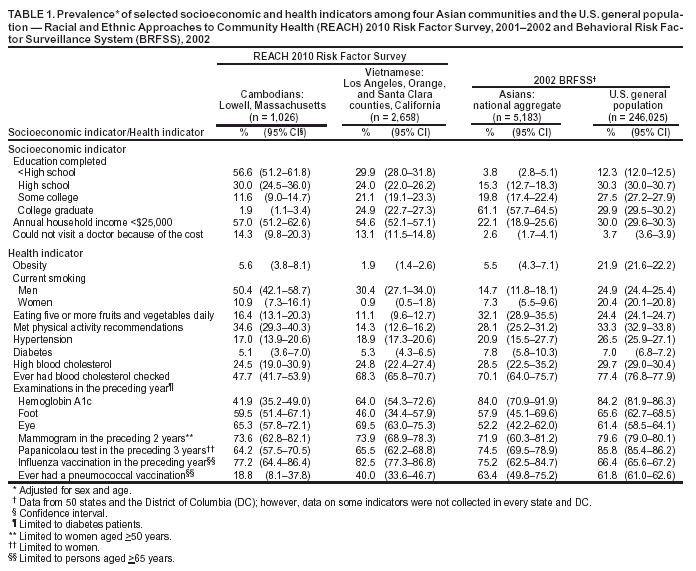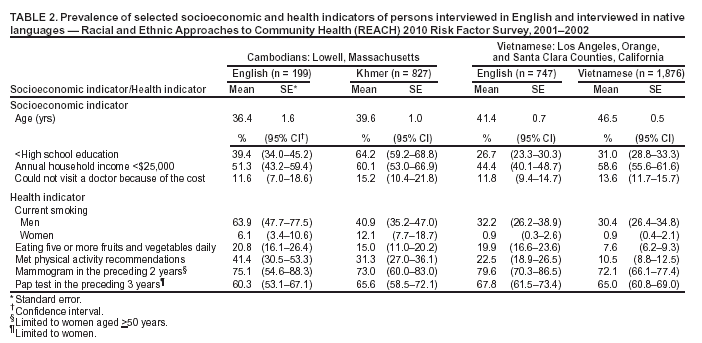 |
|
|
|
|
|
|
| ||||||||||
|
|
|
|
|
|
|
||||
| ||||||||||
|
|
|
|
|
Persons using assistive technology might not be able to fully access information in this file. For assistance, please send e-mail to: mmwrq@cdc.gov. Type 508 Accommodation and the title of the report in the subject line of e-mail. Health Status of Cambodians and Vietnamese --- Selected Communities, United States, 2001--2002National health data often are reported for Asians in the aggregate and do not monitor the health of specific Asian subpopulations (e.g., Cambodians and Vietnamese) in the United States (1,2). In addition, surveys conducted in English exclude Cambodians and Vietnamese with limited English proficiency. This report summarizes and compares health data from 1) a survey of one Cambodian and three Vietnamese communities conducted during 2001--2002 for the Racial and Ethnic Approaches to Community Health (REACH) 2010 project and 2) a survey of Asians in the aggregate and the general U.S. population conducted by the 2002 Behavioral Risk Factor Surveillance System (BRFSS). The questions were identical on both surveys. The results of this analysis indicated that Cambodians and Vietnamese had lower levels of education and household income and substantially different health-risk profiles than both the aggregate Asian population and the general U.S. population. Public health agencies should examine the health status of racial/ethnic subpopulations and prioritize interventions that address disparities. In 1999, CDC launched the REACH 2010 project to support efforts by minority community coalitions to eliminate health disparities (3). As part of surveillance and evaluation, CDC contracted with the National Organization for Research at the University of Chicago to conduct annual REACH 2010 Risk Factor Surveys in project communities. During June 2001--August 2002, a baseline survey was conducted in 21 minority communities in 14 states. The detailed survey methodology has been published (4). For this report, data from Vietnamese communities in Los Angeles, Orange, and Santa Clara counties, California, were combined; Cambodian data were from Lowell, Massachusetts, where 57% of the Asian population is Cambodian. Vietnamese respondents were interviewed by telephone; Cambodians were interviewed in person on the advice of local REACH project staff. In Lowell, 199 (19%) of the interviews were conducted in English, and 827 (81%) were conducted in Khmer. In the three Vietnamese communities, 747 (28%) of the interviews were conducted in English, 1,876 (71%) in Vietnamese, and 1% in Chinese. Response rate was 93% in the Cambodian community and 72% in the combined Vietnamese communities. All data were self reported. Respondents were considered to have fulfilled physical activity recommendations if they participated in moderate physical activity for >30 minutes per day, 5 days per week, or participated in vigorous physical activity for >20 minutes per day, 3 days per week. Data were weighted to represent the communities surveyed, and SUDAAN was used to account for the complex survey and sample design. Prevalence estimates were standardized to the sex and age distribution of the population in the 2000 U.S. Census. The REACH 2010 survey sampled 1,026 Cambodians and 2,658 Vietnamese. The 2002 BRFSS survey sampled 5,183 Asians from a total adult sample of 246,025 from 50 states and the District of Columbia (Table 1). Although Asians in the aggregate had higher education and income than the general U.S. population, Cambodians and Vietnamese had substantially lower education and income. The surveyed Cambodians and Vietnamese were at least three times more likely to report not visiting a doctor because of the cost than were all Asians or all U.S. residents. Among men, greater proportions of Cambodians (50.4%) and Vietnamese (30.4%) smoked than aggregate Asians (14.7%) and the general U.S. population (24.9%). Among women, prevalence of self-reported smoking was higher among Cambodians (56 [10.9%]) than both Vietnamese (15 [0.9%]) and aggregate Asians (274 [7.3%]) but lower than the prevalence in the general U.S. population (29,992 [20.4%]). Cambodians (153 [16.4%]) and Vietnamese (294 [11.1%]) were less likely to report eating five or more fruits and vegetables a day, and Vietnamese (365 [14.3%]) were less likely to meet physical activity recommendations, compared with aggregate Asians (977 [28.1%]) and the general U.S. population (32,450 [33.3%]). Fewer than half of surveyed Cambodians (477 [47.7%]) reported ever having their blood cholesterol checked. Cambodians with diabetes were the least likely (40 [41.9%]) to have had a hemoglobin A1c test in the preceding year. Cambodian and Vietnamese women had lower rates of Papanicolaou tests (64.2% and 65.5%, respectively) than women in the aggregate Asian and general U.S. populations (74.5% and 85.8%, respectively). Approximately 18.8% of Cambodians and 40.0% of Vietnamese aged >65 years reported ever having pneumococcal vaccine, compared with 63.4% of aggregate Asians and 61.8% of the general U.S. population. Persons interviewed in English had different characteristics than those interviewed in Khmer or Vietnamese (Table 2). For example, Cambodians interviewed in their native language were on average older (39.6 years versus 36.4 years), more likely to have less than a high school education (64.2% versus 39.4%), annual household income of <$25,000 (60.1% versus 51.3%), and to report cost as a barrier to obtaining health care (15.2% versus 11.6%). Vietnamese interviewed in English had a higher fruit and vegetable intake (19.9% versus 7.6%) and reported more leisure-time physical activity (22.5% versus 10.5%). Among men in the Cambodian community, prevalence of smoking was higher among those interviewed in English (63.9% versus 40.9%); however, among women, the opposite pattern was observed (6.1% versus 12.1%). Reported by: S Koch-Weser, MS, D Grigg-Saito, MS, S Liang, Lowell Community Health Center; R Toof, MS, Univ of Massachusetts Lowell; NN Kreth, Southeast Asian Bilingual Advocates; M Pot, MA, Cambodian Mutual Assistance Assoc, Massachusetts. MA Foo, MPH, Orange County Asian and Pacific Islander Community Alliance; HL Foong, PALS for Health/Special Svc for Groups; M Kagawa-Singer, PhD, UCLA School of Public Health and Asian American Studies; SW Lee, JH Tran, MPH, Orange County Asian and Pacific Islander Community Alliance; TN Nguyen, PhD, UCLA School of Public Health, Los Angeles; SP Tanjasiri, DrPH, Div of Kinesiology and Health Science, California State Univ, Fullerton; TT Nguyen, MD, SJ McPhee, MD, Vietnamese Community Health Promotion Project, Univ of California, San Francisco, California. Y Liao, MD, P Tucker, DrPH, W Giles, MD, Div of Adult and Community Health, National Center for Chronic Disease Prevention and Health Promotion, CDC. Editorial Note:Asians are the fastest-growing racial population in the United States. During April 1, 2000--July 1, 2003, the Asian population increased an estimated 12.5% to 13.5 million (5). In 2000, Cambodians and Vietnamese constituted 12% of the U.S. Asian population. In the mid-1970s, large numbers of Cambodians and Vietnamese began arriving in the United States, primarily as refugees. These refugees faced socioeconomic and language challenges often different from persons in other Asian subpopulations that had been established in the United States for multiple generations. The findings in this report revealed differences in health status among Asian subpopulations, including Cambodians and Vietnamese. For example, the data indicated that among Cambodian and Vietnamese men and women in the surveyed communities, pronounced differences in smoking prevalence existed that were not evident in the aggregate Asian population; in addition, higher proportions of Cambodian and Vietnamese men reported smoking than the overall Asian general U.S. populations. Because the average age for smoking initiation has been estimated at 17 years among Vietnamese and 14 years among Cambodians (6), tobacco-use prevention efforts in these populations should focus on youths. Contrary to traditional diets in their countries of origin (7,8), Cambodians and Vietnamese also reported less fruit and vegetable consumption. Reports have suggested that fruits and vegetables have been perceived as more costly in the United States in some populations (7). Data on physical activity indicate substantial differences between Cambodians and Vietnamese. The low prevalence of physical activity among Vietnamese in California was reported previously (9) and indicates a need for programs to promote physical activity among Vietnamese adults. Although self-reported prevalence of hypertension, diabetes, and high cholesterol among Cambodians and Vietnamese were similar to or lower than prevalences among aggregate Asians and the general U.S. population, these data should be examined in relation to data regarding less access to health care and lack of screenings. Respondents with limited English also might be unaware of their chronic conditions because of poor communication with health-care providers. In Lowell, Massachusetts, where the majority of Asians are Cambodian, Asians aged >45 years die from diabetes at higher rates than the general Massachusetts population (10). A major strength of the REACH 2010 survey was that interviews could be conducted in native languages. Previous nationwide surveys, such as those conducted by BRFSS, have included only questions and answers in English. The findings in this report indicate substantial differences between persons interviewed in English and in their native languages. A survey that accommodates both English and the native language also is a demonstration of respect and sensitivity to the community and might help increase survey participation, even among English speakers. The findings in this report are subject to at least three limitations. First, the REACH 2010 survey included only one Cambodian and three Vietnamese communities, and the data might not be representative of other Cambodian and Vietnamese communities in the United States. Second, because estimates are based on self-reported data, the prevalence of some chronic conditions and the percentage of the population using preventive services might be under- or overestimated. Finally, food-frequency questions concerned mostly Western eating habits, which might not be culturally appropriate in certain Asian subpopulations. The results of this analysis underscore the need for public health agencies to study the health status of racial/ethnic subpopulations. Whenever possible, communities should gather local data to guide program planning and evaluation. REACH 2010 health intervention projects are ongoing in the four communities described in this report. The Vietnamese Community Health Promotion Project (http://www.suckhoelavang.org) is targeting cervical cancer among Vietnamese women in Santa Clara County, Promoting Access to Health for Pacific Islander and Southeast Asian Women is working to increase breast- and cervical-cancer screening and follow-up in Los Angeles and Orange counties, and the Cambodian Community Health 2010 project in Lowell is promoting cardiovascular health and diabetes prevention. Additional surveillance and targeted interventions will be needed to address the disparities in health between these subpopulations and the overall Asian and general U.S. populations. References
Table 1  Return to top. Table 2  Return to top.
Disclaimer All MMWR HTML versions of articles are electronic conversions from ASCII text into HTML. This conversion may have resulted in character translation or format errors in the HTML version. Users should not rely on this HTML document, but are referred to the electronic PDF version and/or the original MMWR paper copy for the official text, figures, and tables. An original paper copy of this issue can be obtained from the Superintendent of Documents, U.S. Government Printing Office (GPO), Washington, DC 20402-9371; telephone: (202) 512-1800. Contact GPO for current prices. **Questions or messages regarding errors in formatting should be addressed to mmwrq@cdc.gov.Page converted: 8/26/2004 |
|||||||||
This page last reviewed 8/26/2004
|